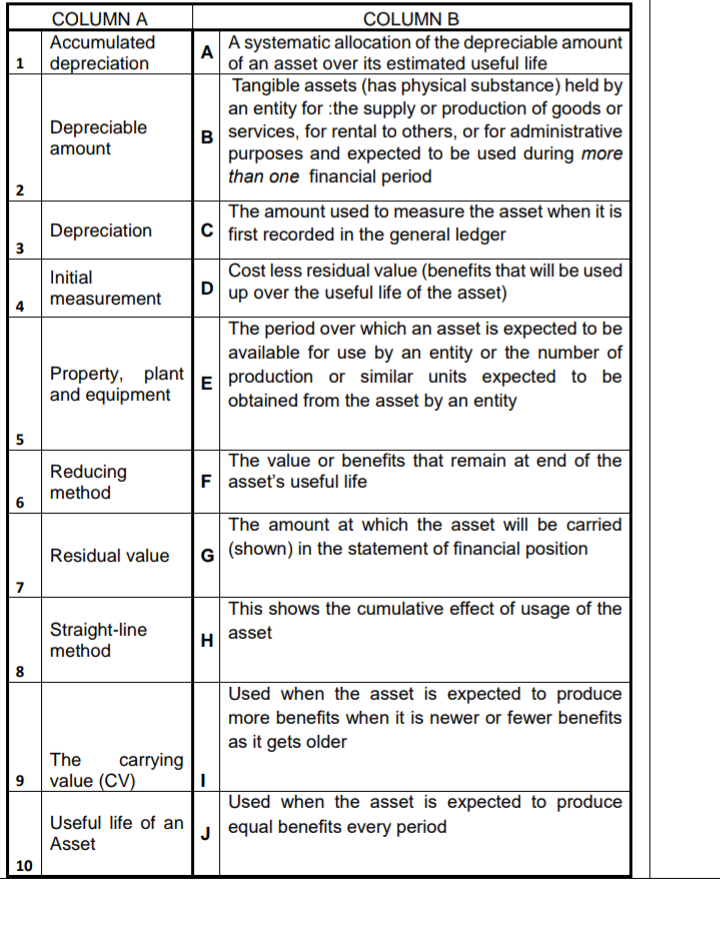COLUMN A Accumulated 1 depreciation 2 3 5 6 7 8 Depreciable amount 10 Depreciation Initial measurement Property, plant and equipment Reducing method Residual value Straight-line method The 9 value (CV) carrying Useful life of an Asset COLUMN B A A systematic allocation of the depreciable amount of an asset over its estimated useful life Tangible assets (has physical substance) held by an entity for the supply or production of goods or B services, for rental to others, or for administrative purposes and expected to be used during more than one financial period The amount used to measure the asset when it is C first recorded in the general ledger D Cost less residual value (benefits that will be used up over the useful life of the asset) E The value or benefits that remain at end of the Fasset's useful life The amount at which the asset will be carried G (shown) in the statement of financial position H The period over which an asset is expected to be available for use by an entity or the number of production or similar units expected to be obtained from the asset by an entity I J This shows the cumulative effect of usage of the asset Used when the asset is expected to produce more benefits when it is newer or fewer benefits as it gets older Used when the asset is expected to produce equal benefits every period
COLUMN A Accumulated 1 depreciation 2 3 5 6 7 8 Depreciable amount 10 Depreciation Initial measurement Property, plant and equipment Reducing method Residual value Straight-line method The 9 value (CV) carrying Useful life of an Asset COLUMN B A A systematic allocation of the depreciable amount of an asset over its estimated useful life Tangible assets (has physical substance) held by an entity for the supply or production of goods or B services, for rental to others, or for administrative purposes and expected to be used during more than one financial period The amount used to measure the asset when it is C first recorded in the general ledger D Cost less residual value (benefits that will be used up over the useful life of the asset) E The value or benefits that remain at end of the Fasset's useful life The amount at which the asset will be carried G (shown) in the statement of financial position H The period over which an asset is expected to be available for use by an entity or the number of production or similar units expected to be obtained from the asset by an entity I J This shows the cumulative effect of usage of the asset Used when the asset is expected to produce more benefits when it is newer or fewer benefits as it gets older Used when the asset is expected to produce equal benefits every period
Cornerstones of Financial Accounting
4th Edition
ISBN:9781337690881
Author:Jay Rich, Jeff Jones
Publisher:Jay Rich, Jeff Jones
Chapter7: Operating Assets
Section: Chapter Questions
Problem 29BE
Related questions
Question
Match

Transcribed Image Text:COLUMN A
Accumulated
1 depreciation
2
3
5
6
7
8
9
10
Depreciable
amount
Depreciation
Initial
measurement
Property, plant
and equipment
Reducing
method
Residual value
Straight-line
method
carrying
The
value (CV)
Useful life of an
Asset
COLUMN B
A
A systematic allocation of the depreciable amount
of an asset over its estimated useful life
Tangible assets (has physical substance) held by
an entity for the supply or production of goods or
B services, for rental to others, or for administrative
purposes and expected to be used during more
than one financial period
The amount used to measure the asset when it is
C first recorded in the general ledger
D
Cost less residual value (benefits that will be used
up over the useful life of the asset)
The value or benefits that remain at end of the
F asset's useful life
The amount at which the asset will be carried
G (shown) in the statement of financial position
H
The period over which an asset is expected to be
available for use by an entity or the number of
production or similar units expected to be
obtained from the asset by an entity
I
J
This shows the cumulative effect of usage of the
asset
Used when the asset is expected to produce
more benefits when it is newer or fewer benefits
as it gets older
Used when the asset is expected to produce
equal benefits every period
Expert Solution
This question has been solved!
Explore an expertly crafted, step-by-step solution for a thorough understanding of key concepts.
Step by step
Solved in 2 steps

Knowledge Booster
Learn more about
Need a deep-dive on the concept behind this application? Look no further. Learn more about this topic, accounting and related others by exploring similar questions and additional content below.Recommended textbooks for you

Cornerstones of Financial Accounting
Accounting
ISBN:
9781337690881
Author:
Jay Rich, Jeff Jones
Publisher:
Cengage Learning

Financial Accounting: The Impact on Decision Make…
Accounting
ISBN:
9781305654174
Author:
Gary A. Porter, Curtis L. Norton
Publisher:
Cengage Learning

Survey of Accounting (Accounting I)
Accounting
ISBN:
9781305961883
Author:
Carl Warren
Publisher:
Cengage Learning

Cornerstones of Financial Accounting
Accounting
ISBN:
9781337690881
Author:
Jay Rich, Jeff Jones
Publisher:
Cengage Learning

Financial Accounting: The Impact on Decision Make…
Accounting
ISBN:
9781305654174
Author:
Gary A. Porter, Curtis L. Norton
Publisher:
Cengage Learning

Survey of Accounting (Accounting I)
Accounting
ISBN:
9781305961883
Author:
Carl Warren
Publisher:
Cengage Learning

Principles of Accounting Volume 1
Accounting
ISBN:
9781947172685
Author:
OpenStax
Publisher:
OpenStax College